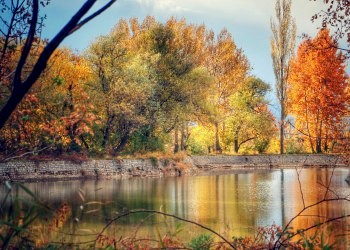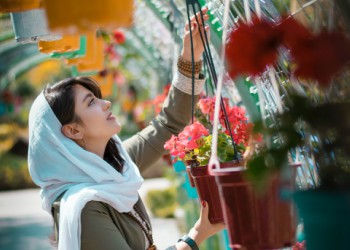What is the best time to visit Iran? The good news is Iran has a great variety of places and experiences for you all year round since Iran weather has a wide range in all seasons. Maybe the best way to choose about the time of your trip is to decide according to your itineraries and your destinations in Iran.
However, there are some general facts about Iran’s climate. First of all, despite its variability, Iran is an arid or semi-arid country. Most of Iran’s classic attractions and UNESCO registered sites are also located in the arid parts of Iran.
Besides Iran is a four-season country. You can enjoy cold weather and snow during winter, blossoms in spring, delicious colorful fruits, and hot weather during summer and rainy weather and yellow leaves in autumn during your trip to Iran.
This variety of seasons provides a chance for you to choose the best time for your trip according to your favorite activities and travel planning.
In this article, you can find general facts about Iran weather and also the various climates in different parts of Iran in different months.
Also read: Travel to Iran: Tips for First Travelers
Some facts about Iran’s climate diversity
Knowing about the geographical characteristics of Iran helps you to have more information about Iran’s climate diversity. There are two mountain ranges in Iran, Alborz in the north and Zagros in the west, which have a great impact on the weather diversity in Iran plateau. In addition, Iran has two main deserts, Lut and central, in which the weather is hot and dry during most time of the year.
In the northern part of Iran, the coastal line of the Caspian Sea, Gilan, Mazandaran and Golestan provinces, the weather is humid and rainy throughout the year except the summer (June, July, and August). However, the humidity is soaring and the weather is very hot during the summer. Though even during these months, there is delicate weather in mountainous regions of Alborz Mountain.

The southern part of the country, Khuzestan, Hormozogan, Bushehr and, Sistan and Baluchestan provinces, has hot weather from mid-spring to late summer. In other seasons, the weather is moderate in these places. Central Iran is also arid for most of the year.
As you may see this is a very rough categorization of Iran weather according to the geographical characteristics of a different region. Different cities in each part of Iran has some differences, so you should check your itineraries before your trip.
From mid-March to early June and mid-September to late November the weather is mild in most parts of Iran. You can enjoy spring and autumn weather in most cities. This is the best time for your trip if you wish to visit different parts of Iran.
Traveling Iran during winter

The southern part of Iran is a great destination during winter (November-February). You can enjoy mild weather and all water recreation on the coasts of the Persian Gulf. The amazing islands in the Persian Gulf like Kish and Qeshm are top destinations you can visit in winter.
With a one and half hour flight from the southern part of Iran to Tehran, you can experience skiing in different ski resorts like Dizin, Abali, Darbandsar, and Shemshak near Tehran. The good news is that they have accommodation and you can enjoy spending some days of your trip amid the snow.
Read also: A Complete Guide to Travel Tehran
Summer trip to Iran

During summer (June to August), most parts of Iran are hot. However, you can still enjoy cool weather in northwestern provinces like Ardebil and some mountainous regions.
Iran has some stunning waterfalls mostly in the western part of Iran that you can visit during summer. Lorestan and Chahar Mahal Va Bakhtiari provinces in western Iran are home to magnificent waterfalls.
But cities like Shiraz, Isfahan, Kashan, and Tehran are dry and hot during this season. Humidity in the south and north part of the country is also high during summer.
Dreamy autumn in Iran

If you travel Iran during autumn, do not miss the scenic Hyrcanian forests in northern Iran.
From September to November you can enjoy mild weather in most parts of the country.
The trees with orange and yellow leaves mesmerize you in all streets.
It is a great time for walking and strolling in cities and sightseeing in most parts of Iran.
You can also spend some nights at accommodation in the heart of Iran’s deserts and enjoy the pleasant weather of autumn and starry nights of the desert.
Spring beauties in Iran

From March to May, you can enjoy beauty blossoms and fresh weather of spring in different parts of the country. It is a great time to travel to different parts of Iran. Shiraz, as one of the most favorite destinations in Iran, has fascinating spring with bitter orange blossoms and their fragrance in the air.
You can enjoy the beauty of nature in every part of the country. On March 21, Iranians celebrate Nowruz, the Iranian New Year, and the longest vacation for Iranians for about two weeks. Hence, many places may be closed for but you can enjoy this ancient celebration and its ritual if you travel to Iran during this time.
The peak and low seasons in Iran
From March to May is considered the peak season in Iran. The temperature is mild in most parts of Iran. However from March 20 to April 3, is Iranian New Year (Nowruz) vacation in the country and some famous cities like Isfahan, Yazd, Shiraz, and Kashan are very crowded. Remember that in April, the price of accommodations goes up and is not available in some cases.
From November to February is the low season of Iran. Cold weather and some impassable roads especially in mountainous regions make the rate of traveling lower in the country. During these months, you can find hotels and accommodation with a discount.
The shoulder season in Iran is from June to October. September and October are maybe a wise time for traveling since the weather is moderate.
Last but not the least
Iran is a four-season country. Hence, it is finally up to you to plan for your travel to the country. At each time of the year, you can find entertainment and sightseeing in different parts of Iran.
Remember that Iran generally has warm and dry weather. Most renowned tourist attractions are located in regions with a hot climate. However, you can choose your time and itineraries according to your favorite experiences and activities. Iranians welcome you with open arms whenever you arrive!


1 Comment
Pingback: Travel to Iran: Tips for First Travelers - Exotigo